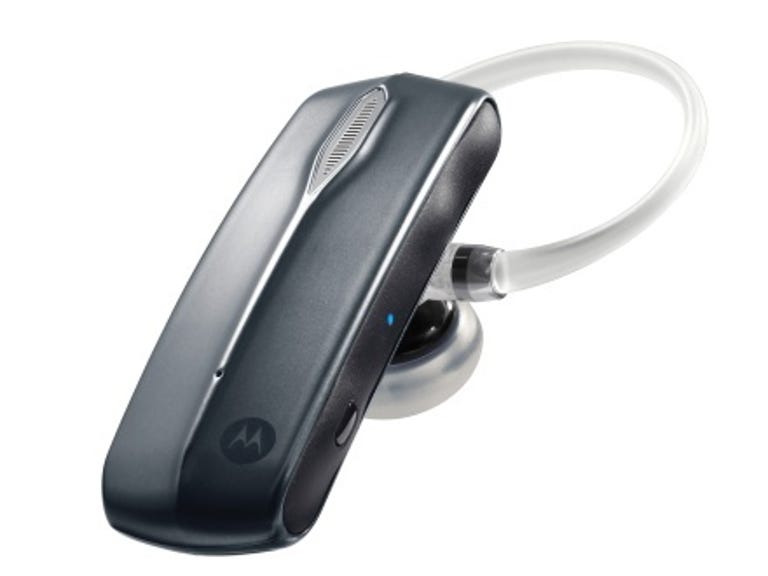 Why You Can Trust CNET
Why You Can Trust CNET Motorola CommandOne Bluetooth Headset review: Motorola CommandOne Bluetooth Headset
Motorola CommandOne Bluetooth Headset
Motorola may be better known for its Android smartphones these days, but the company also makes accessories like Bluetooth headsets. One of its most recent headsets is the Motorola CommandOne, which features Motorola's own CrystalTalk noise cancellation technology along with A2DP streaming, multipoint, and voice prompts. It's also compatible with a mobile app that will let you send and receive text messages without ever touching the phone. The Motorola CommandOne is available for $99.99 retail.
The Good
The Bad
The Bottom Line
There's not much to say about the CommandOne's design; it looks like a standard Bluetooth headset at 2.13 inches long by 0.73 inch wide by 0.43 inch thick. The rectangular headset is clad in a shiny gray plastic on the front, and the sides are covered in a soft rubber material. The headset is also curved slightly outward so that it better suits the curvature of the face.
On the front of the CommandOne is a slim diamond grid opening that houses one of the headset's microphones. A little farther down on the front is a tiny status light that lights up when the headset is charging. On the top of the headset are the Micro-USB charging port and a very small multipurpose call button. It is a tiny little raised rubber point, so small that we completely missed it at first glance and had to refer to the manual to figure out its location. It's not difficult to press, but we wish it was a bit more prominent.
On the left side of the headset is the power slider, which we can use to easily turn the headset on and off. On the right are the volume rocker, mute button, and another status LED light that flashes when the headset is in use.
On the back of the headset is the earpiece clad in Motorola's TrueComfort ear gel cover. The headset comes with covers of different sizes if you want more options. It also comes with a flexible ear hook that can be rotated to fit either ear. The ear hook is not really optional, as you do need it to keep the headset from falling off. We found the overall fit to be quite comfortable--the earpiece sits gently inside the ear without going in too deeply.
As we mentioned above, the CommandOne has a number of features. Aside from the usual calling features like last number redial and voice command support, it also has A2DP streaming and multipoint, which lets you connect the headset to up to two devices. It also has a series of voice prompts that guide you through pairing the headset, and it can let you know the status of the headset's battery levels if you press both volume buttons simultaneously while not on a call. If you pair the CommandOne with an Apple iPhone, you'll see the headset's battery meter in the upper-right corner.
Another unique feature of the CommandOne is its compatibility with MotoSpeak, Motorola's Android application that can read incoming text messages. It will also let you reply to them via voice dictation, or you can say "Call back" and the phone will automatically start a call. We tested this app with the LG Vortex, but it constantly crashed whenever we received a text message. We also tested this app with the Motorola Bravo, where it worked quite well. This tells us the app might not work depending on what phone you have, so beware of that.
With the Motorola Bravo, we thought MotoSpeak worked well for the most part. It did read incoming text messages in a very stilted robotic tone, but that's to be expected. It will also read back your dictated message before you send it. We managed to understand it most of the time, but a few words did slide toward incomprehensibility because of the robotic tone. As for whether the phone recognized our words, again, it did so quite well. It only messed up a couple of times, and that was when we were leaving really long text messages. Therefore, we would encourage you to keep your messages short and simple when using this app.
We paired the Motorola CommandOne with the LG Vortex, the Motorola Bravo, and the Apple iPhone 4. The headset does connect to two phones at a time, as long as you make sure to turn off the first phone while you pair the second. Make sure to turn on the first phone immediately afterward if you want a simultaneous connection. The CommandOne will state in the voice prompt which phone is connected.
Call quality was good, if a little mixed. On our end, the call quality was about the same with all three phones: callers sounded loud and clear, though there were the telltale signs of a cell phone call with the occasional static and buzz. We also often heard a slight echo effect.
As for outgoing sound quality, Motorola's CrystalTalk dual-microphone noise cancellation does do a good job of blocking out extraneous sound--we tested it in a restaurant during the busy lunch hour and our callers still heard us clearly. However, voice quality varied depending on the phone we used. With the Vortex, callers said we sounded a little distorted, and the echo effect seemed more pronounced. With the Bravo, our voice quality was crystal clear, but a little overly processed. Surprisingly, the call quality was the best with the Apple iPhone 4, which was both natural-sounding and clear. We're not able to test the headset with all phones, of course, but we were pleased with the call quality overall.
The Motorola CommandOne has a rated battery life of 5 hours of talk time and seven days of standby time.


